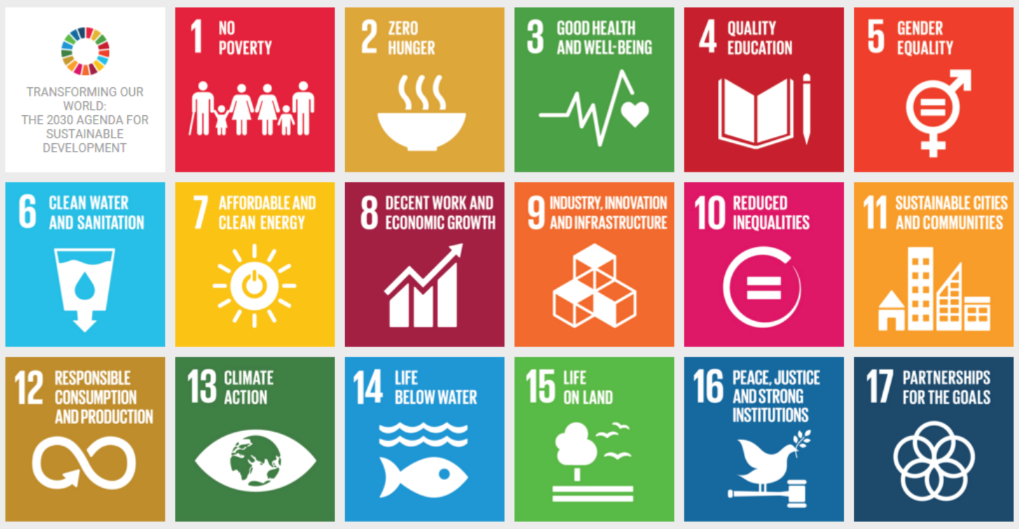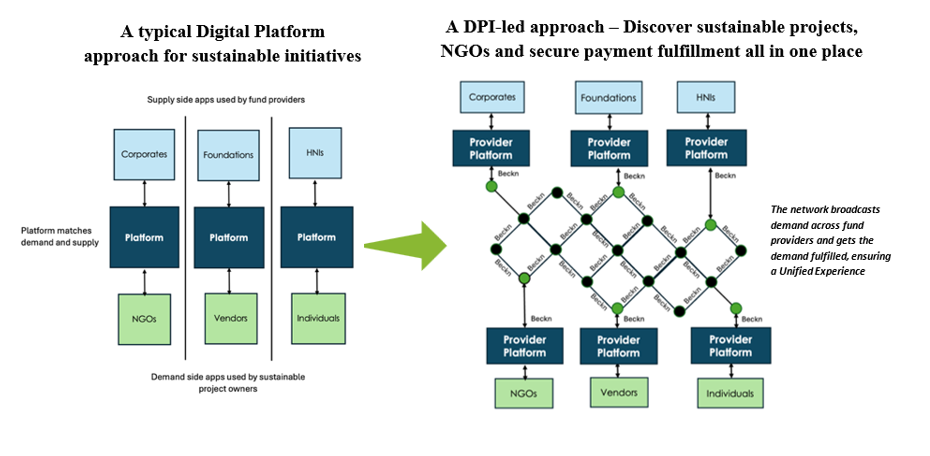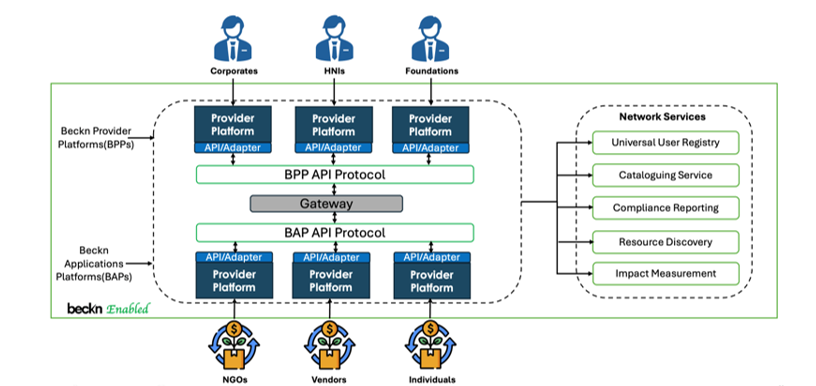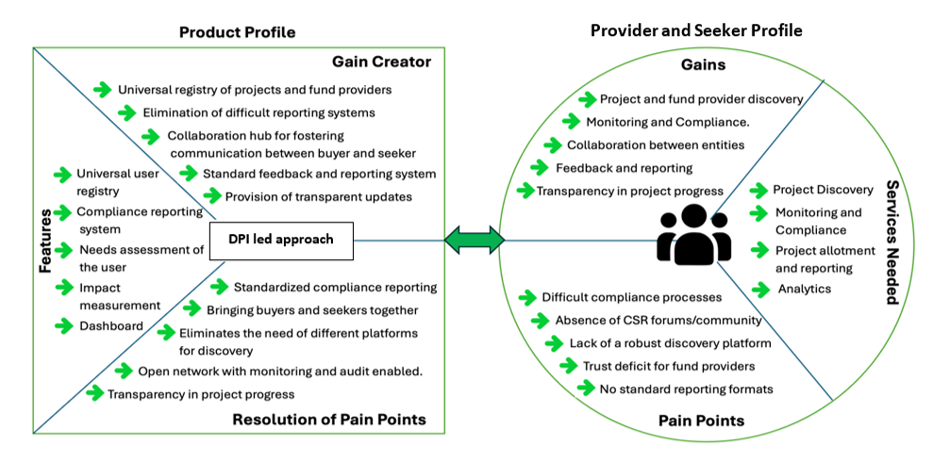Abstract
The persistent challenge of securing the necessary resources to meet sustainable goals necessitates finding ways to bridge the gap between available resources and required actions. This white paper outlines how a Digital Public Infrastructure approach can solve for the associated challenges, thus empowering individuals and communities to connect with resources and provide support for a dignified life.
The approach is to create an interconnected ecosystem where Seekers (individuals, NGOs, implementing agencies) and Providers (corporations, foundations, individuals) can collaborate transparently and efficiently to address social and environmental challenges. By integrating verifiable credentials, fostering trust through decentralized public goods (DPGs), and incentivizing sustainable actions with carbon and green credits, this ecosystem would enable progress towards achieving the United Nations Sustainable Development Goals (SDGs).
The Challenge: A Disconnected Landscape of Unsustainability
Despite the significant growth in social sector spending, reaching an estimated ₹23 lakh crore (US$280 billion) in FY2023[1], the landscape of philanthropy and corporate social responsibility (CSR) remains fragmented. Seekers often struggle to find suitable funding and resources, while Providers face challenges in identifying impactful projects and ensuring efficient utilization of funds. Traditional approaches often suffer from fragmentation, limited reach, absence of CSR forums, compliance documentation, and lack of coordination, thereby, hindering progress towards the execution of projects and CSR compliances. A DPI-led approach seeks to address this by fostering a more inclusive and impactful ecosystem for universal sustainability.
Inspiration from Digital Public Infrastructure (DPI)
The emergence of DPI in India, exemplified by CoWIN (vaccination platform) and ONDC (open e-commerce network), demonstrates the transformative power of open networks. These initiatives create efficient and accessible platforms, empowering individuals and fostering collaboration (Carnegie India, 2024[2]). This whitepaper draws inspiration from this model, aiming to facilitate:

A Vision for Interconnected Sustainability
This interconnected ecosystem envisions global reach, transcending geographical boundaries connecting:
Providers:
- Corporations, foundations, and philanthropic individuals to showcase their resources, expertise, and funding capabilities. They can identify impactful projects that align with their sustainability goals and connect with Seekers to initiate collaborations.
- Corporates and Philanthropist: Those seeking opportunities to contribute towards the sustainable goals through philanthropic acts.
- Foundations and Consulting Firms: To create the demand for basic necessities and seek opportunities from corporates and philanthropists.
Seekers
- Implementing Agency and Vendors: To manage the distribution of certain resources (e.g., food vouchers, educational scholarships) based on needs assessment and eligibility criteria. They ensure efficient and transparent allocation of resources.
- Resource Providers: Organizations and individuals with the capacity to offer resources like educational institutions, healthcare providers, and international aid agencies.
- Individuals, NGOs, and implementing agencies can easily discover relevant funding opportunities and resources through standardized APIs. They can express their needs, search for suitable Providers, and initiate projects with transparency and efficiency.
Matching algorithms, informed by standardized data and local context considerations, will connect stakeholders with relevant resources. This collaborative flow of information, resources, and action fosters a more efficient and impactful system for achieving universal sustainability. This ecosystem focuses on the Sustainable Development Goals by United Nations to contribute towards a sustainable and responsible future.

The Philanthropy Landscape
The philanthropy market consists of private philanthropists and corporates as the major players in the market. India’s social sector spending witnessed robust annual growth of 13% over the last five years, reaching approximately Rs 23 lakh crore ($280 billion) in FY2023. This growth is primarily fuelled by public spending however CSR and Private Philanthropy are the major categories for private funds.

A Digital Public Infrastructure enabling Universal Sustainability
This approach envisions a globally accessible, decentralized open ecosystem that addresses these challenges by fostering collaboration and transparency. Leveraging the Beckn protocol, Seekers and Providers can be connected through a seamless, standardized ecosystem, enabling efficient discovery, project management, compliance reporting, fund transfers, and impact measurement.

Leveraging Beckn protocol's core principles:
- Open Protocol: Ensures interoperability and prevents vendor lock-in, allowing diverse stakeholders to participate.
- Decentralized Architecture: Distributes control and ownership, promoting transparency and resilience.
- Standardized APIs: Facilitates seamless communication and data exchange between different platforms and applications.
- Ecosystem Participants: Includes seekers (corporations, philanthropists), providers (implementing agencies, resource providers), and gateway providers (to facilitate communication).
Current landscape and challenges:
- Seekers: Struggle to find suitable funding and resources, limited options and information available.
- Providers: Difficult to identify impactful projects and ensure efficient utilization of resources.
- Impact: Limited visibility and fragmented data make it challenging to assess the overall impact of sustainable development efforts.

Transaction Flow
- Search: Seekers (e.g., a corporation seeking to fund a clean water project) initiate a search for relevant projects or resources.
- Discovery: The network acts as a gateway, connects the seekers with relevant providers (e.g., NGOs specializing in clean water projects) based on their needs and preferences.
- Catalogue: Providers provide detailed information about their projects or resources, including budget, impact metrics, and implementation plans.
- Selection: Seekers evaluate the options and select a project or resource that aligns with their goals.
- Order: Seekers place an order, specifying the project or resource and the desired funding amount.
- Fulfilment: Providers receive the order and initiate the project or resource delivery, following standardized protocols and reporting progress.
- Payment: Upon successful completion, secure payment is facilitated from the providers to seekers, ensuring transparency and accountability.
- Rating and Feedback: Seeker and Providers rate and provide feedback on their experience, contributing to the overall trust and quality of the ecosystem.

Value Proposition
For Seekers:
- Increased Visibility: Access to a wider range of funding opportunities and resources.
- Efficient Matching: Seamless connection with suitable Providers based on specific needs and criteria.
- Transparent Project Management: Real-time tracking of project progress and impact.
For Providers:
- Diverse Pool of Projects: Access to a wide array of projects aligned with their sustainability goals.
- Streamlined Due Diligence: Standardized processes for evaluating proposals and verifying credentials.
- Efficient Resource Allocation: Optimized allocation of funds and resources to maximize impact.
- Robust Impact Measurement: Accurate and transparent assessment of project outcomes.
For the Ecosystem:
- Increased Transparency: Open data and auditable transactions build trust and credibility.
- Reduced Fragmentation: Unified ecosystem fosters collaboration and knowledge sharing.
- Accelerated Project Implementation: Streamlined processes expedite project execution.
- Greater Impact: Maximized collective impact in achieving sustainable development goals.
Digital Credentialing: Building trust and transparency
Public trust in philanthropy is a cornerstone of the sector's ability to function effectively. However, a growing concern is the potential for misuse of donated funds. This erosion of trust can be attributed to a number of factors, including a lack[3] of transparency in how charities operate and uncertainty regarding the legitimacy of beneficiaries. Surveys on public trust among philanthropy initiatives indicate that only 34% of public trust the projects or initiatives funded by private philanthropists and corporate initiatives remain at a steady 37% of public trust.
An open ecosystem incorporates verifiable credentials, digitally signed attestations of qualifications, achievements, or attributes, ensuring decentralized trust-by-design. These credentials are issued by trusted authorities and are cryptographically verifiable, ensuring their authenticity and tamper-proof nature. Leveraging DPI and DPGs like Sunbird Registry and Credential, a secure and interoperable framework for issuing and verifying credentials can be enabled.
One can verify the authenticity of these credentials using Sunbird RC's verification capabilities. Use of open-source solutions as Sunbird, further strengthens the security. The transparency allows all participants to scrutinize credential schemas, ensuring they accurately reflect sustainability efforts. By implementing VCs, a secure and reliable foundation for collaboration and data exchange on sustainability initiatives can be established.

Use cases:
- Donation Verification: Donors receive VCs as proof of their contributions, verifying the amount, date, and recipient organization.
- Impact Reporting: Organizations issue VCs to beneficiaries, documenting the positive outcomes achieved through CSR projects, such as education, healthcare, or skill development.
- Grant Applications: Nonprofits can use VCs to streamline grant applications, demonstrating their track record and impact to potential funders.
- Volunteer Verification: Volunteers receive VCs to validate their participation in CSR activities, facilitating recognition and future engagement.
- Supply Chain Transparency: VCs can track the origin and ethical sourcing of materials used in products, ensuring compliance with CSR standards.
- Community Engagement: VCs can be used to recognize and reward community members for their contributions to social and environmental causes.
Decentralized Trust and Reputation
By incorporating a blockchain based architecture, a more reliable and trustworthy ecosystem for sustainable practices can be created. Trust scores based on verifiable ratings can incentivize participants to maintain high sustainability standards. This transparency empowers users to make informed choices that align with their values, ultimately contributing to a more sustainable ecosystem.
- Rating and Review System: Distributed ledgers can manage a secure system for the ecosystem participants to rate and review each other's interactions. This could include feedback on factors like product sustainability credentials, transaction timeliness, or adherence to ethical practices.
- Trust Scores and Reputation Management: Based on accumulated ratings and reviews trust scores for each participant can be generated. This empowers users to make informed decisions by considering a participant's reputation for sustainable practices.
Benefits of Trust Management:
- Transparency and Immutability: All ratings and reviews stored on blockchain are tamper-proof and transparent. This fosters trust in the ecosystem.
- Decentralized Governance: This promotes a fairer system where trust is established organically through user interactions.
- Scalability and Security: Blockchain's inherent scalability ensures efficient handling of a growing ecosystem. Additionally, blockchain's robust security safeguards sensitive user data.
Green Credits: Incentivizing Sustainable Actions
Such an ecosystem can go beyond traditional funding models by integrating the concept of carbon and green credits. These credits, representing verified reductions in carbon emissions or positive environmental impact, can be earned by Providers for their sustainable projects. Seekers can use these credits to offset their own carbon footprint or support projects that align with their environmental goals.
The Green Credits initiative stands with the theme of corporates and policy makers to consider and implement fair and legitimate ways of issuing Carbon Credits. This initiative further strengthens the following arguments indicated by the GS Sustain Report, 2022[4].
As highlighted in the G20 2023[5] report, issuance of VCs for Carbon Credits, can be utilised to represent various elements of a carbon credit, such as its emission reduction methodology, verification status, and ownership. By adhering to W3C standards, market participants can ensure compatibility and seamless integration of VCs, facilitating secure and reliable exchange of information on carbon credits.
This can be potentially used to facilitate the recognition of Green Capex and contribution projects which reduces GHG (Greenhouse Gases) emissions.
- Project Verification: Independent auditors verify the environmental impact of projects and issue corresponding carbon or green credits.
- Credit Issuance: Credits are issued and recorded on the blockchain, ensuring transparency and immutability.
- Trading and Offsetting: Seekers can purchase credits from Providers to offset their carbon footprint or invest in sustainable projects.
- Incentivized Sustainability: The ability to earn and trade credits incentivizes Providers to adopt sustainable practices and contribute to environmental conservation.
Additional Features
- Smart Contracts: Blockchain-based smart contracts can be utilized to automate specific processes, such as payment release upon project milestones or verification of impact metrics.
- Data Analytics: Data analytics can further be leveraged to gain insights into the effectiveness of different projects and resources, enabling continuous improvement.
Value Proposition
- For Seekers: Increased visibility of funding opportunities, efficient matching with suitable Providers, transparent project management, and enhanced accountability.
- For Providers: Access to a diverse pool of impactful projects, efficient allocation of resources, streamlined due diligence processes, and robust impact measurement.
- For the Ecosystem: Increased transparency, reduced fragmentation, accelerated project implementation, and greater overall impact in achieving sustainable development goals.

Facilitating Secure Flow: Implementation Agencies and Trustee Banks
An ecosystem of trusted implementation agencies will be responsible for verifying the legitimacy of both project creators and project implementors (agencies and vendors). Additionally, a network of accreditation agencies can also come onboard to establish standard for programs and ensure legal issuance of certificates and receipts. Both creators and implementors will benefit for their contribution to social responsibilities.
Key Functionalities
- Universal User Registry: A secure and inclusive registry for demand-side (corporates, philanthropists, foundations, consulting firms) and supply-side (implementing agencies, vendors) stakeholders.
- Needs Assessment: To articulate their specific needs for basic necessities.
- Resource Discovery: A search engine that leverages standardized data and context-aware matching algorithms to connect stakeholders with relevant resources based on location, thematic areas, and specific needs.
- Collaboration Hub: An ecosystem for fostering communication and collaboration between resource providers, support networks, and beneficiaries.
- Impact Measurement Framework: A robust framework for tracking and measuring the impact of interventions, promoting transparency and accountability.
- Compliance Reporting: Consistent data formats, auditable records of transactions, compliance reports, and impact assessments.
- Enhanced Visibility of Needs: Increase global visibility of needs and resources, connecting those in need with geographically dispersed solutions.
- Optimized Resource Allocation: Match resources with needs more efficiently, leading to a more impactful and equitable utilization of global support.
- Empowering Local Solutions: Empower local communities by facilitating knowledge sharing and promoting context-specific solutions.
- Fostering Global Collaboration: Encourage collaboration between international aid agencies, NGOs, and local support networks for better-coordinated efforts.
Key Stakeholders
The success of DPI-led approach hinges on collective action:
- National Governments: To integrate existing social welfare programs and encourage participation from local NGOs and resource providers.
- International Organizations: To leverage their global reach and expertise and facilitate resource mobilization on the ecosystem.
- Technology Experts: To contribute to the development of a secure, scalable, and user-friendly platforms accessible across different regions.
- Civil Society Organizations (CSOs): To connect with beneficiaries, share best practices, and collaborate on regional and global initiatives.
Conclusion
A DPI-led approach presents a visionary way to achieve universal sustenance on a global scale. By leveraging open protocols, fostering collaborations, and promoting knowledge sharing, individuals and communities can be empowered worldwide. This white paper offers a starting point for a global conversation and collaborative effort towards a more sustainable future where everyone has access to the basic necessities for a dignified life.
Our collaborative work on the DPI article, with guidance from the co-chair of CDPI, reflects our commitment to their visionary goals, advancing sustainable innovation together.
About the Authors:
Dr. Pramod Varma is the former Chief Architect of Aadhaar, India's digital identity program that has successfully covered more than 1.3 billion people. He was also the chief architect for various India Stack layers such as eSign, Digital Locker, and Unified Payment Interface (UPI), and Data Empowerment and Protection Architecture (DEPA), and all of which are now working at population scale in India. He played an integral role in architecting India’s digital health infrastructure (ABDM), vaccination & immunization infrastructure (Co-WIN and DIVOC), and Unified Health Interface (UHI). He is currently the CTO of EkStep Foundation, a not-for-profit creating learner-centric digital public goods under Project Sunbird (sunbird.org).
He also helped design India’s digital education & skilling architecture blueprint called NDEAR. In addition, he is the Co-Founder of FIDE.org, he is the genesis author of the open source beckn protocol (becknprotocol.io) that helps create decentralized open discovery, fulfillment, and transaction networks. He is also an adjunct faculty and Co-Chair at the global Center for DPI (CDPI.dev) , a non-profit, helping countries design and architect their own Digital Public Infrastructure systems in addition to building local capacity. He is an advisor to Unique Identification Authority of India (UIDAI), National Payment Corporation (NPCI), Goods and Services Tax Network (GSTN), National Health Authority (NHA), Securities and Exchange Board of India (SEBI), Open Network for Digital Commerce (ONDC), Turing Institute Identity Initiative in the UK, and helps with many Digital Public Infrastructure (DPI) initiatives in India and across the globe. Pramod holds a Master’s and Ph.D. degree in Computer Science along with a second Master’s in Applied Mathematics. His interests include Internet scale distributed architectures and intelligent systems. He is passionate about technology, science, society, and teaching
Suresh Sethi has over three decades of diversified global experience in the financial services industry and works extensively in the financial inclusion space, leveraging fintech and digital led innovation to make a difference. He is currently the Managing Director & CEO of Protean eGov Technologies Ltd., a pioneer and market leader in building Digital Public Infrastructure (DPI). Over the last 28 years, Protean has been one of the cornerstones of Digital India evolution - right from creating population scale e-governance platforms for taxation and social security (Pension CRA) to enabling digital identity through foundational DPIs across Identity, Payments & Data. Aligned with India’s visionary DPI framework built on open standards and protocols, Protean continues to contribute towards multisectoral Open Digital Ecosystems across ecommerce, mobility, agriculture, education & health.
In his last role, as the Founder CEO & MD of India Post Payments Bank, he established the largest inter-operable banking infrastructure for public good at scale in India.
Prior to India Post Payments Bank, as the Managing Director & CEO of Vodafone M-Pesa, he was responsible for defining and developing the M-Pesa business strategy for India and shaping the digital and mobile payments space in the country. In his earlier assignments, he has worked with leading financial services companies such as Citigroup and YES Bank across multiple geographies covering India, Kenya, UK, Argentina and US. Suresh has been a key industry spokesperson and closely engages with the government and regulatory institutions to aid policy formulation in a rapidly changing industry.
For his contribution to the financial services sector, Suresh has been recognized by The Asian Banker and is part of The Asian Banker’s "List of Leading Practitioners". He was also recognized as the CEO of the Year (India Post Payments Bank) at the India Banking Summit & Awards, 2019.
About CDPI:
CDPI (Centre for Digital Public Infrastructure) is a pro bono tech architecture advisory team that helps countries implement digital public infrastructure (DPI) solutions. The CDPI's mission is to help countries design technology architecture and drive inclusive, innovative, and competitive national growth. Their approach to promote DPI is to use pre-packaged solutions, make DPI cloud-ready, and reduce the need for governments to build internal tech capacity. CDPI is housed at an academic institute - the International Institute of Information Technology, Bengaluru.
About Protean:
Incorporated in December 1995, Protean eGov Technologies (BSE: PROTEAN, formerly NSDL e-Governance Infrastructure) is engaged in the business of developing citizen-centric and population-scale e-governance solutions. Protean is an information technology-enabled solutions company conceptualizing, developing, and executing critical and population-scale greenfield technology solutions. The company collaborates with the Indian government and has extensive experience in creating digital public infrastructure and developing innovative citizen-centric e-governance solutions.
References
[1] India Philanthropy Report 2024: https://www.bain.com/insights/india-philanthropy-report-2024/
[2] The Future of Digital Public Infrastructure: https://carnegieendowment.org/research/2024/02/the-future-of-digital-public-infrastructure-a-thesis-for-rapid-global-adoption?lang=en
[3] Trust In Civil Society: https://independentsector.org/wp-content/uploads/2022/05/Independent-Sector-Trust-Report-2023.pdf
[4] GS Sustain 2022, Report: GS SUSTAIN Green Capex Accelerating the Energy Transition Stimulating capital and return on capital (goldmansachs.com)
[5] G20 2023, Report: Carbon Credit Issuance, Verification, Tracking, and Standardisation Through Various Means | ThinkTwenty (T20) India 2023 - Official Engagement Group of G20 (t20ind.org)

